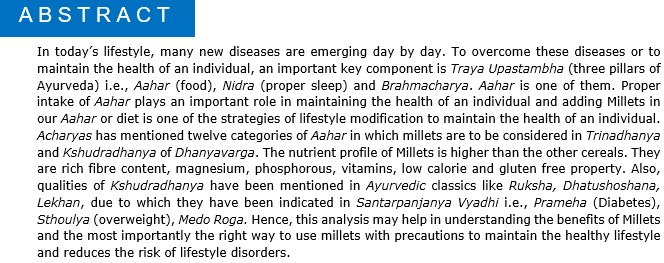An eyeshot on the role of Millets in healthy lifestyle - A Literary Review
DOI:
https://doi.org/10.21760/jaims.8.9.25Keywords:
Aahar, Ayurveda, Kshudradhanya, Millets, Santarpan Janya VyadhiAbstract
In today’s lifestyle, many new diseases are emerging day by day. To overcome these diseases or to maintain the health of an individual, an important key component is Traya Upastambha (three pillars of Ayurveda) i.e., Aahar (food), Nidra (proper sleep) and Brahmacharya. Aahar is one of them. Proper intake of Aahar plays an important role in maintaining the health of an individual and adding Millets in our Aahar or diet is one of the strategies of lifestyle modification to maintain the health of an individual. Acharyas has mentioned twelve categories of Aahar in which millets are to be considered in Trinadhanya and Kshudradhanya of Dhanyavarga. The nutrient profile of Millets is higher than the other cereals. They are rich fibre content, magnesium, phosphorous, vitamins, low calorie and gluten free property. Also, qualities of Kshudradhanya have been mentioned in Ayurvedic classics like Ruksha, Dhatushoshana, Lekhan, due to which they have been indicated in Santarpanjanya Vyadhi i.e., Prameha (Diabetes), Sthoulya (overweight), Medo Roga. Hence, this analysis may help in understanding the benefits of Millets and the most importantly the right way to use millets with precautions to maintain the healthy lifestyle and reduces the risk of lifestyle disorders.
Downloads
References
Acharya Kaiyadeva. Dhanya Varga. In: Prof priya vrat Sharma, Dr. guru Prasad Sharma (eds.) Kaiyadeva Nighantu (Pathyaapathya vibhodaka). Varanasi: Choukhambha Orientalia; 2009.p.318-321.
Bhavamishra, Dhanya Varga.In: Srikantha Murthy, K.R (ed.) Bhavaprakash. Varanasi: Choukhamba Krishna das Academy. 2011: p-374-377.
Stanley Joseph and A. Shangmugam. A study on Millets based cultivation and consumption in India. International journal of Marketing, Financial Services and Management research, April 2013 Vol 2. No 4,3662.
Sarita Ekta Singh. The potential of Millets: Nutrients Composition and Health Benefit, Journal of Scientific and Innovative Research, 2016.5(2):46-50.
Madanpala nirupa, Madanpala Nighantu, Published by Ganga Vishnu Sri Krishnadas, Bombay, 1867,Tpg-296.
Nighantu Ratnakara, edited by Bhishagvarya navra krishnashastri, published by Jawaji Vasudev, Bombay 1936, pg- 808.
Corke H, Huang Y, Li JS. Coix: an overview. Encyclopedia of food grains, 2016 Jan 1; 1:184-9
Lucky OF, Ifedayo OA. Gulnea Corn (Sorghum vulgare) Leaf, a Potential Source of Nutrients and Phytochemicals. Food and Public Health. 2012;2(6):228-30.
Wahnschaffe U, Schulzke JD, Zeitz M, Ullrich R. Predictors of clinical response to gluten free diet in patients diagnosed with diarrhea – predominant irritable bowel syndrome. Clinical Gastroenterology and Hepatology. 2007 Jul 1;5(7):844-50.
Shweta Malik, Pearl Millet- Nutritional Value and Medicinal uses (Food & Nutrition) Dept. of Home Science, B.P. S.Women’s University Khanpur Kalan (Hry) www.ijariie.com,2015 Vol-1 Issue 3.
ICAR - Indian Institute of Millets Research, 2017 (IIMR).
Kumari PL, Sumathi S. Effect of consumption of finger millet on hyperglycemia in non-insulin dependent diabetes mellitus (NIDDM) subjects. Plant foods for Human Nutrition. 2002 Sep;57(3): 205-13.
Mathanghi, S.K. and K. Sudha. Functional and phytochemical properties of finger millet for health, International Journal of Pharmaceutical, Chemical and biological sciences,2012.2(4):431-438.
Nayak S, Meti R. Development of multi millet therapeutic food product for Type 2 Diabetes.
Jun DY, Lee JY, Han CR, KIM KP, Seo MC, Nam MH, Kim YH. Pro- apoptotic and anti- adipogenic effects of Proso millet grains on 3t3-1 preadipocytes. Journal of Life Science. 2014;24(5):505-14
Shimanuki S, Nagasawa T, Nishizawa N. Plasma HDL subfraction levels increase in rats fed proso-millet protein concentrate. Medical science monitor. 2006 Jul 1;12(7):BR221-6.
Joshi. S. Srivastava S. Barnyard Millet as a substitute of rice in preparation of Khichdi for diabetics. Int J Sci Res. 2016;5(6):1798-802.
Deshpande, S. S., Mohapatra, D., Tripathi. M. K., and Sadvatha R. H. Kodo millet- Nutritional Value and Utilization in Indian Foods, ICAR- Central Institute of Agricultural Engineering, Nabibagh, Journal of Grain Processing and Storage 2015. Vol 2.
Anderson, J.W. Whole grains protect against artherosclerotic cardiovascular disease. Proceedings of the Nutrition Society, 2003. 62:135-142.
Gaitan E, Lindsay RH, Reichert RD, INGBAR SH, Cooksey RC, Legan J, MEYDRECH EF, HILL J, KUBOTA K. Antithyroid and goitrogenic effects of Millets: role of C-glycosylflavones. The journal of Clinical Endocrinology & Metabolism.1989 Apr 1;68(4): 707-14.















